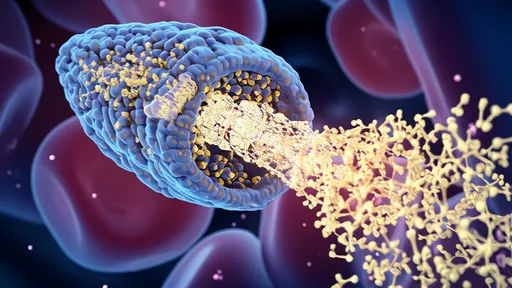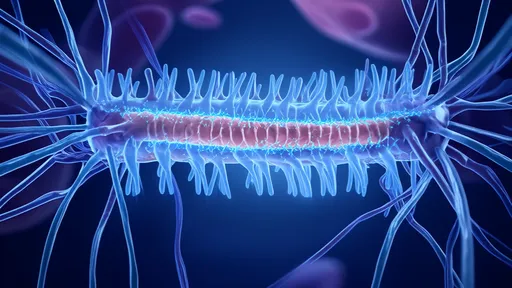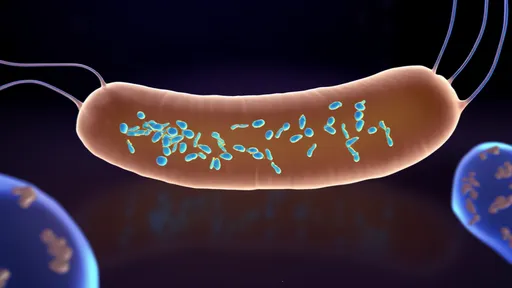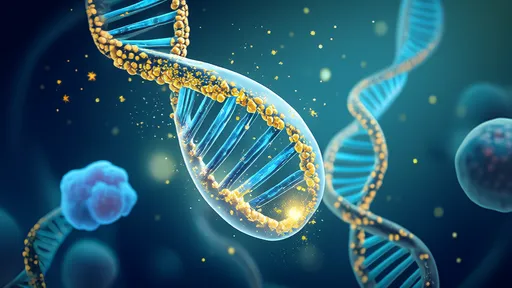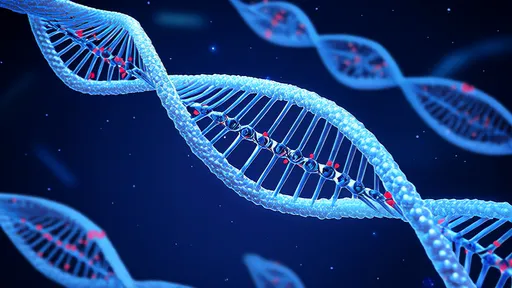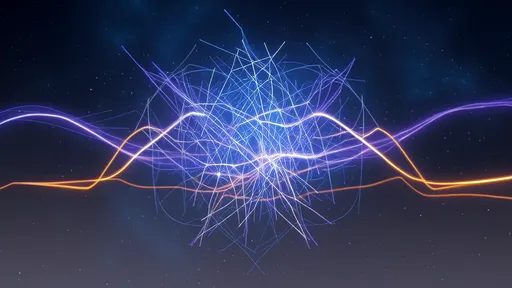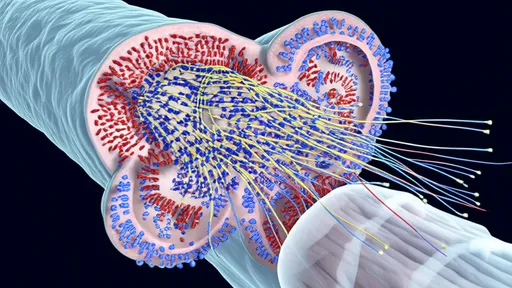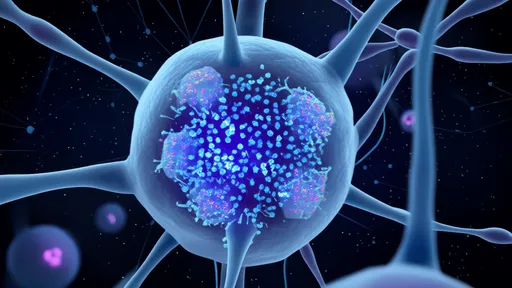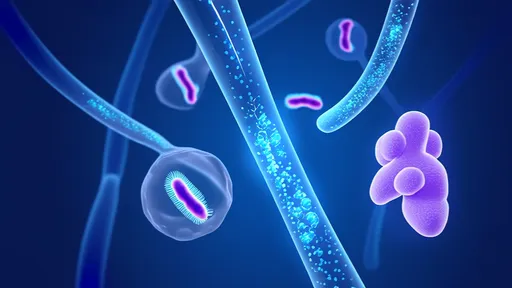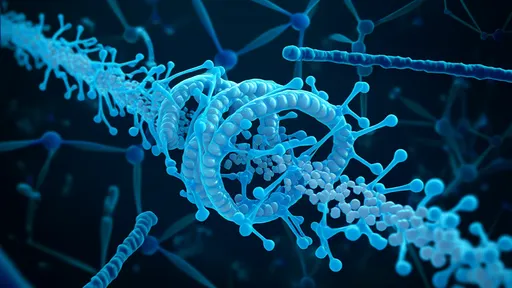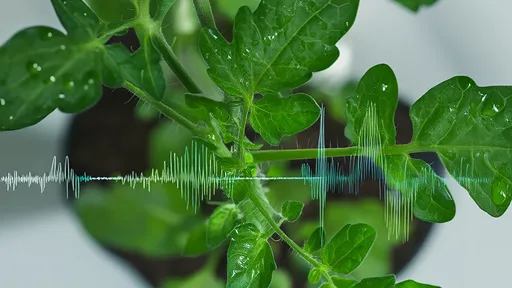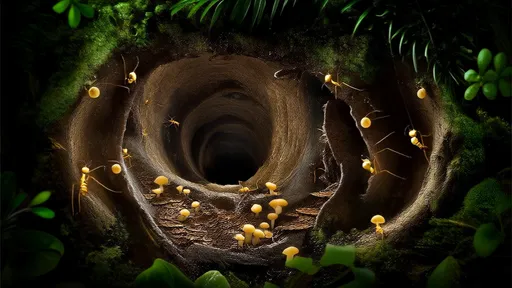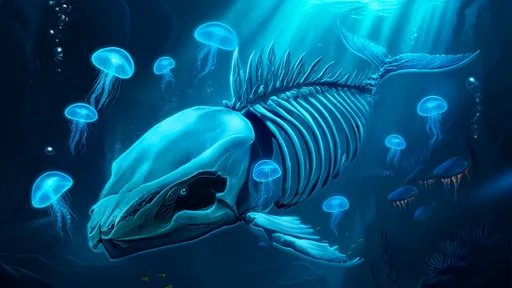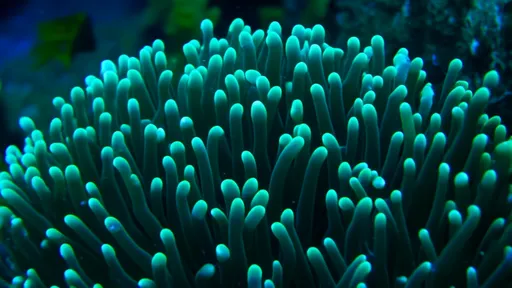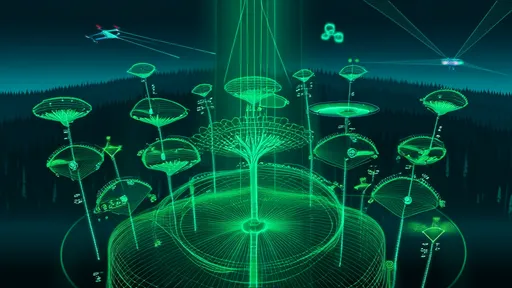In a groundbreaking discovery that could revolutionize coral reef monitoring, scientists have identified a natural early warning system for coral bleaching events. Certain coral species exhibit vivid fluorescent patterns when under thermal stress, acting as biological "sentry lights" that signal the onset of bleaching before visible damage occurs. This phenomenon, observed in reef-building corals across the Indo-Pacific, represents nature's own climate change alert system.
The mechanism centers on the complex relationship between corals and their symbiotic algae. When water temperatures rise beyond tolerable limits, the photosynthetic apparatus of the symbiotic dinoflagellates (Symbiodiniaceae) begins to malfunction. This triggers a cascade of biochemical reactions that cause certain coral pigments to fluoresce with increased intensity. Researchers have documented this response occurring days or even weeks before the actual expulsion of algal symbionts - the defining characteristic of coral bleaching.
Dr. Maria Rodriguez, lead marine biologist at the Global Coral Observatory, explains: "What we're witnessing is essentially a cry for help. The corals aren't just passively deteriorating - they're actively communicating their distress through spectacular light displays. Some species glow electric blue, while others take on neon green or fiery orange hues. This isn't random bioluminescence; it's a precise optical warning system that's been evolving for millions of years."
The discovery emerged from long-term monitoring projects using customized spectral imaging equipment. Scientists noticed that specific fluorescence patterns consistently preceded bleaching events across multiple reef systems. Further laboratory experiments confirmed that the intensity of certain fluorescent proteins directly correlates with the level of thermal stress and the likelihood of subsequent bleaching.
What makes this finding particularly valuable is its potential for large-scale reef monitoring. Current satellite-based systems can only detect bleaching after it's already occurred, when coral tissues have turned white from algal loss. The fluorescence signal, by contrast, provides advance warning when intervention might still make a difference. Conservation teams are now developing drone-mounted sensors capable of mapping these fluorescent signatures across entire reef systems.
The biological basis for this phenomenon involves sophisticated light-manipulating proteins that corals produce in response to stress. These proteins appear to serve multiple functions: protecting remaining symbionts from excess light, attracting different algal strains that might be more heat-tolerant, and possibly even communicating with neighboring coral colonies. Some researchers speculate the fluorescent display might function as a "distress beacon" to symbiotic organisms in the surrounding water.
Field studies have revealed intriguing variations in this capacity among coral species. Massive boulder corals tend to show the most dramatic fluorescent responses, while delicate branching species display subtler changes. Certain reefs in the Coral Triangle exhibit particularly strong signals, suggesting local adaptation to frequent thermal fluctuations. This natural variation provides crucial clues for identifying heat-resistant genotypes that could be prioritized for reef restoration projects.
As ocean temperatures continue rising due to climate change, this discovery couldn't be more timely. Marine biologists estimate that nearly 30% of the world's coral reefs have already been lost to bleaching events since 1980. The ability to predict bleaching before it occurs could allow for targeted interventions such as temporary shading, assisted migration of heat-tolerant symbionts, or localized cooling measures. Several conservation organizations are already prototyping early warning systems based on this research.
However, scientists caution that fluorescence monitoring is not a silver bullet. While it provides crucial early detection, it doesn't eliminate the root causes of bleaching. "The flashing colors are beautiful but tragic," notes Dr. Hiro Tanaka of the Okinawa Marine Science Institute. "They're showing us the reefs' incredible resilience mechanisms, but also how close they're pushing to their breaking point. Early warnings won't matter if we don't address climate change and water quality issues."
Ongoing research aims to refine the technology for widespread use. Teams are working to distinguish stress-induced fluorescence from normal diurnal variations in coral pigmentation. Other studies investigate whether artificial intelligence can predict bleaching likelihood based on complex fluorescence patterns. The ultimate goal is creating a global network of automated sentinel reefs that provide real-time data on impending bleaching events.
This biological early warning system represents a rare piece of good news in coral conservation. By learning to interpret nature's own signaling language, scientists and conservationists gain precious time to protect vulnerable reef ecosystems. As the research progresses, these glowing corals may literally light the way toward more effective reef preservation strategies in our rapidly warming oceans.
For decades, the blood-brain barrier (BBB) has stood as a formidable gatekeeper, selectively shielding the brain from harmful substances while frustrating efforts to deliver life-saving therapeutics. This biological fortress, while essential for protecting our most vital organ, has rendered many promising treatments for neurological disorders ineffective. Now, a groundbreaking approach combining protein engineering and artificial intelligence is cracking the code to safe BBB penetration, potentially revolutionizing treatment for Alzheimer's, Parkinson's, and brain cancers.
In a groundbreaking development that could revolutionize the treatment of spinal cord injuries, researchers have successfully engineered hydrogel-based optical fibers capable of mimicking neural pathways. These "neural optical fibers" represent a fusion of advanced materials science and neurobiology, offering new hope for patients with previously untreatable damage to their central nervous system.
In a groundbreaking discovery that could revolutionize our approach to plastic waste, scientists have identified a surprising ally in the fight against polyethylene pollution: the humble wax worm. More specifically, the bacteria residing in the gut of these caterpillar-like creatures have demonstrated an extraordinary ability to break down one of the world's most stubborn plastics. This finding opens new avenues for tackling the global plastic crisis through biological means.
In a groundbreaking development that challenges our understanding of aging, scientists have demonstrated the potential to reverse cellular aging through a technique called transient reprogramming. This approach temporarily rewinds the epigenetic "clock" of cells without erasing their identity, opening new possibilities for regenerative medicine and age-related disease treatment.
In a groundbreaking leap for precision medicine, researchers have unveiled a light-controlled CRISPR delivery system using DNA-origami "nanodrones" – a fusion of nanotechnology and gene editing that promises unprecedented control over therapeutic targeting. This innovation, emerging from a collaboration between bioengineers and geneticists, reimagines drug delivery by combining the programmability of DNA nanostructures with the spatial precision of optogenetics.
In a groundbreaking study that could reshape our understanding of consciousness, neuroscientists have identified the thalamic reticular nucleus (TRN) as a potential "rhythmic switch" governing wakefulness through gamma wave modulation. This almond-shaped inhibitory structure, often described as the brain's gatekeeper, appears to orchestrate states of awareness by tuning neural oscillations like a conductor leading a symphony of consciousness.
For decades, chronic pain has remained one of medicine's most elusive challenges – a complex interplay of biological, psychological, and social factors that often defies conventional treatment. Now, groundbreaking research into the spinal cord's neural "fingerprints" of pain is revolutionizing our understanding of how persistent pain becomes etched into the nervous system. Scientists are mapping specialized neural circuits that appear to encode chronic pain with remarkable specificity, opening new avenues for targeted therapies.
In a groundbreaking discovery that reshapes our understanding of brain metabolism, researchers have identified glial cells as the unsung architects of neuronal energy distribution. The study reveals how these long-overlooked support cells orchestrate the precise mitochondrial allocation to neurons, challenging the neuron-centric dogma of neuroscience. This paradigm shift underscores glial cells' role as metabolic conductors in the symphony of brain function.
Scientists have uncovered a startling new pathway by which gut microbes communicate with the brain at lightning speed. Dubbed the "10-second gut-brain superhighway," this discovery centers on the vagus nerve's ability to transmit microbial signals faster than previously thought possible. The findings could revolutionize our understanding of conditions ranging from depression to irritable bowel syndrome.
In a groundbreaking discovery that bridges molecular biology and neuroscience, researchers have uncovered how the CPEB protein acts as a "molecular glue" to solidify long-term memories through an elegant phase transition mechanism. This finding not only revolutionizes our understanding of memory persistence but also reveals nature's ingenious solution to maintaining information at the molecular level.
In a groundbreaking discovery that blurs the line between botany and acoustics, researchers have uncovered evidence of tomatoes employing ultrasonic warfare against herbivorous insects. The study, published in Nature Plants, reveals how tomato plants emit high-frequency sounds when under attack - not as passive victims, but as active participants in their own defense.
In the dense rainforests of Central and South America, leafcutter ants have perfected an architectural marvel that puts human climate control systems to shame. These tiny engineers construct elaborate underground nests spanning hundreds of square feet, maintaining near-perfect temperature and humidity levels year-round – without using a single watt of electricity. As architects and engineers grapple with the urgent need to reduce building emissions, these insect-built structures offer profound lessons in passive climate regulation.
The depths of the ocean hold secrets that continue to astonish scientists, and among the most enigmatic phenomena is the "whale fall"—the carcass of a deceased whale sinking to the seabed. These massive organic deposits create transient ecosystems, supporting diverse marine life for decades. But beyond the visible scavengers and bone-eating worms, a hidden microbial world thrives, and within it, something extraordinary has been discovered: colossal bacteriophages, viruses that prey on bacteria, with genomes so large they defy conventional understanding.
In a groundbreaking discovery that could revolutionize coral reef monitoring, scientists have identified a natural early warning system for coral bleaching events. Certain coral species exhibit vivid fluorescent patterns when under thermal stress, acting as biological "sentry lights" that signal the onset of bleaching before visible damage occurs. This phenomenon, observed in reef-building corals across the Indo-Pacific, represents nature's own climate change alert system.
In a groundbreaking development for ecological research and climate science, researchers have harnessed advanced LiDAR technology to map the photosynthetic efficiency of trees across vast forested areas. Dubbed the "carbon pulse" of forests, this innovative approach provides unprecedented insights into how trees absorb and process carbon dioxide at an ecosystem scale. The implications for understanding carbon sequestration, forest health monitoring, and climate change mitigation strategies are profound.
